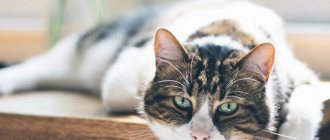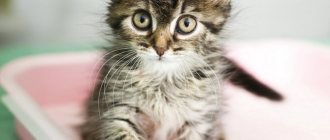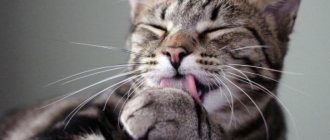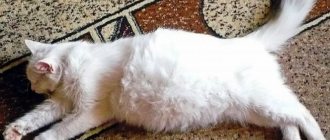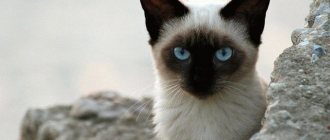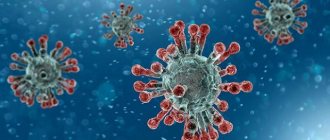In the last century, the age limit for cats rarely reached 10 years, and only a few lived to reach the 15-year mark. True, in those days the main task of cats was to protect food supplies from rodents. Hence injuries, infections and early death.
Now life expectancy for cats has increased significantly thanks to veterinary care, quality nutrition and a calmer lifestyle.
Stages of a cat's life cycle
The life of any cat can be divided into several stages.
Infancy (from birth to six months)
The first six months of a baby’s life are the most significant and eventful. Ten days after birth, these are blind sucklings, whose whole world is concentrated in the warmth of the mother’s body and the nipple with milk.
By two months, kittens become quite independent, begin to feed on their own, and learn to use a litter box.
Until three or four months, the pets usually do not leave the nursery and the mother. From four to six, they resemble playful children on the cusp of adolescence.
Youth (from six months to two years)
In almost all breeds, by six months the kitten is at the beginning of puberty. Physically, he is already quite developed, almost independent.
Usually at one year the female is already able to give birth and feed kittens, although it is better if pregnancy occurs a little later, at least at 18 months. Cats mature more slowly - up to one and a half years, and in some breeds up to two or three years.
Youth (three to six years old)
Animals are considered conditionally young when they are between two and six years old. This age approximately corresponds to 20-40 years of a person. It is at the age of six that it is customary in nurseries to remove an animal from breeding.
But with good care, pets are active, healthy and capable of producing full-fledged offspring for much longer - at least up to seven to ten years.
Maturity (seven to ten years)
A cat from seven to ten years old is considered a mature individual. About the same as a person aged 40-55 years old. The animal is in the prime of life, behaves calmly and reservedly.
Older cats (eleven to fourteen years old)
From 11 to 14 years old, the cat is in old age, corresponding to human 55-70 years. If the pet does not suffer from any chronic diseases, then neither he nor the owner will have any special problems in life. Sleep time increases, whims in choosing food may appear, and there is no particular desire for outdoor games.
Old age (over fifteen years)
Pets over 15 years old can be considered 80 year olds. They are calm, unhurried, affectionate, need the attention and care of their owner, and express their devotion more clearly.
This division into age groups is very arbitrary. Many animals at 15 years old are still vigorous, playful and active. There is a known cat of the Nibelung breed that lived 36 years. She gave birth to and nursed her last kittens at 28. By the way, read about long-lived cats on our portal.
Need for veterinary care
Various types of diseases not only shorten life span, but also reduce its quality. If you notice symptoms such as lack of appetite, weakness, or discharge from the eyes, you should immediately contact a veterinarian. Any disease takes away strength and energy. Timely measures taken sometimes save a pet’s life, so it is necessary:
- Carry out preventive examinations regularly. Early detection of pathology will help eliminate it in the initial stage, which will increase the chances of recovery. The quality of examinations depends on how equipped the clinic is with diagnostic equipment: ultrasound scanners, biochemical analyzers, electrocardiographs. Therefore, it is better to take the animal to a clinic where the necessary equipment is available.
- Vaccinate your pet. Annual vaccination will help prevent serious and fatal diseases. Some breeders think that vaccinations are not necessary for stay-at-home cats who do not have contact with other animals. But doctors do not agree with this position, because it is impossible to foresee negative situations in the future: owners can bring in pathogenic bacteria from the street on clothes, shoes, infection can occur in a veterinary clinic, and an encounter with sick rodents is possible.
- Correct treatment. The recovery of your pet largely depends on the professionalism and conscientiousness of the doctor. Doctor's negligence and incorrect choice of treatment regimen lead to complications. Diseases are not completely cured and return, acquiring a chronic form, which significantly depletes the body and shortens the life span.
Sometimes it is worth contacting a cat doctor without a specific reason. The owner will be able to prolong the life of his pet only if he creates favorable living conditions and closely monitors his health. An animal that receives balanced food, is surrounded by care and love, has a good chance of becoming a long-liver among its fellows.
Life of a street and indoor cat
Life expectancy is affected by habitat. Well-groomed and caressed domestic cats live much longer than their street counterparts. The latter have to survive, get food, and hide from the cold in winter. In the cold, death from hypothermia overtakes animals quite quickly.
Kittens born in the basement or on the street die in the first months of life in 90% of cases. The reason for this is weakened immunity, lack of heat and viral diseases. Only the strongest survive, but they have yet to prove their strength in street fights. It is not surprising that they have a short life span - few live up to 7 years, and a 10-year-old street cat will be considered a long-liver.
Animals that end up outside from home find themselves in even worse conditions. Most often, the owners refuse them, indifferently throwing them away like an unnecessary rag. The chances of living at least a year on the street for cats unadapted to such conditions are negligible.
The life of a pet is a different matter. There is good food in the bowl, a warm bed in the room. Vitamins and vaccinations protect against diseases; at the slightest deviation, a caring owner will take all measures to restore the pet’s health.
How many years do street cats live?
Approximately 85% of animals born on the streets die as kittens. This occurs due to weakened immunity, low temperatures, infections, parasites and poisoning. Stronger individuals usually live up to 4-8 years.
The worst situation is for domestic cats that are lost or abandoned by their owners. Being unadapted to such harsh conditions, they die from stress, cold and hunger within the first 3 years.
What affects the life expectancy of cats
With proper care and the absence of genetic or chronic diseases, many indoor cats can live up to 20 years or more. The average life expectancy is 15-17 years, with spayed and neutered animals living 2-4 years longer.
Factors that reduce life expectancy
First of all, it is the habitat. Adequate and regular nutrition, absence of temperature changes, these factors significantly affect life expectancy. Unbalanced nutrition - food from the owner's table, cheap food that does not contain the required amount of nutrients and vitamins, often leads to the development of endocrine diseases and the premature death of the pet.
Also, the period depends on the breed. Genetic predisposition can be traced, as a rule, only in purebred animals. Thus, British cats easily live up to 15 years, and Persian cats - up to 20, but “classic” and “extreme” Persians do not have such longevity and rarely live even up to 15 years. However, breed itself is not an indicator of longer life. Since these cats often have genetic defects that can be caused by inbreeding. For this reason, for example, it is dangerous to knit “Scots” and “British”.
Sexual instinct is another factor influencing life expectancy. Outdoor cats may go into heat three times a year, resulting in pregnancy. Childbirth somewhere in the basement, feeding and pregnancy again greatly depletes the body, doomed to a half-starved existence. The result is a short life.
In domestic unsterilized cats and female cats, hormonal surges and the inability to realize natural instincts can lead to diseases, so in this case, sterilization actually prolongs their life.
The allotted period can be reduced by:
- lack of vaccination and preventive measures;
- free walking, which can end in death under the wheels of a car, a fight with a dog or street cat;
- infection with infectious diseases.
Factors that increase life expectancy
Important factors that will help your pet live as long as possible are:
- Proper nutrition. Food must be balanced, no matter whether it is natural or industrial food. The pet must receive the necessary vitamins and minerals. Feed must be chosen at least at the premium or super-premium level.
- Mandatory and timely vaccination, regular preventive examinations and immediate contact with a veterinarian in case of any deviations in the health and behavior of the pet.
- Sterilization or castration, after which you need to adhere to a special diet.
- Protection from dangers. For domestic cats, this is, first of all, the street, open windows and vents. It is advisable to exclude self-walking and cover the windows with special nets (mosquito nets will not help, you need an anti-cat net).
Regular removal of parasites and preventive treatment will have a positive effect on the health of the animal, and therefore on its life expectancy. Even if the cat has never gone outside in its life, it needs to be treated for fleas and helminths once every 3 months.
Factor table
| Wednesday | Domestic cats are less susceptible to viral diseases and are protected from injury. |
| Nutrition | When balanced with essential vitamins and minerals, it significantly prolongs life. |
| Genetic predisposition | Many artificially bred breeds are susceptible to some kind of disease. |
| Sterilization | Neutered cats do not suffer from reproductive pathologies and are not exposed to stress; sterilized cats live longer than those who often gave birth to kittens. |
| Stress | Street cats are constantly exposed to stress from cold, hunger, and dangers; domestic animals have a calmer life. |
| Predisposition to chronic diseases | If you start treatment in the early stages of the disease, you can significantly prolong the life of your pet; without help, animals with diabetes do not live longer than 4 years, with urolithiasis - longer than 5. |
How to extend your pet's life at home
Felinologists recommend adhering to the rules for keeping domestic cats in order to slow down the approach of old age.
Regular and timely prevention of diseases
Visits to the veterinarian begin at a young age, as soon as the cat has settled in a new home. The usual vaccination algorithm involves mandatory annual vaccination and regular treatment against external and internal parasites. But in addition to standard procedures, you should pay attention to the breed’s tendency to certain diseases.
Almost all cats are susceptible to polycystic disease (genetic kidney disease) in the second half of their lives. It can be diagnosed in the early stages in childhood and a therapeutic treatment regimen can be prescribed.
It will not be possible to get rid of cysts, but the cat can live in this mode for a long time. Recently, breeders have been paying attention to this danger in advance and checking future parents for the presence of the gene responsible for polycystic disease. In such cases, the offspring are no longer at risk.
Cardiomyopathy is a pathology that is common in all cats, regardless of breed. The disease manifests itself in the form of thickening of the wall of the heart muscle. Most often, the left ventricle becomes denser, although in advanced cases the right chamber also loses its ability to pump blood normally.
In this case, early diagnosis means a chance for an extra life. Pets may not sense a crisis approaching for years, but that shouldn't reassure owners. After all, after the first symptoms appear (apathy, refusal to eat, difficulty breathing and shortness of breath), no measures will help, except the use of painkillers.
Important! For examination, it is best to contact specialized clinics. The use of modern diagnostic methods will help to detect dangerous pathologies in time, develop a treatment regimen and prolong the life of domestic cats.
Proper feeding
Diet is an important point in the longevity list of all cats living at home from childhood.
- Animals that have not reached sexual maturity need constant control of calories and a variety of foods - in this case, experts recommend a menu of natural products.
- The active period goes well with industrial feeds - dry granulated or wet mixtures contain many vitamin and mineral supplements.
- In old age, people most often turn to a mixed scheme - combining natural and industrial feeds.
Important! Neutered cats that live indoors are prone to overeating and gaining excess weight. Therefore, the owner must strictly control the number of meals and the volume of portions of the animal.
Hygiene and care for cats at home
General conditions for keeping animals require regular implementation of mandatory hygiene procedures:
- Grooming. It is necessary to comb the coat twice a week, and during molting, this procedure is repeated daily.
- Cleansing the eyes and the area around them - dirty discharge looks very untidy and can even cause some diseases.
- The ears need to be cleaned 2-3 times a month: the upper part is treated with a cotton swab or swab, and in the depths - with drops or lotion.
Important! While the kittens live with their mother, she takes care of the babies. As soon as a young pet gets into the house of a new owner, the owner will have to monitor the cat’s hygiene.
Education and physical activity
Movement and play are very powerful tools for ensuring a cat's longevity. You need to spend at least 1-1.5 hours a day playing active games with your pet.
Raising a cat requires special attention. Despite the fact that representatives of this family have long lived near people, they remain the ancestors of wild animals. Therefore, you will have to raise the kitten from the first days of its life in its new home.
The baby needs to be accustomed to a daily routine, a scratching post, a tray and hygiene procedures. Only then will favorable conditions be created for cats and humans to live together, which will help increase the lifespan of pets.
Limiting stress factors
It is believed that the first year of a cat's life is the most emotional period. At this time, it is necessary to protect young animals from loud sounds, unusual situations and numerous interactions.
All stress factors are divided into categories:
- area of physical irritation - injury or exposure to the external environment;
- biological cause - infection, lack of food or mineral-vitamin complexes;
- chemical components – unpleasant odors, medicines, cosmetics;
- the most common psychological part of stress - even antipathy towards one of the people can put an animal into depression for a long time.
Nervous stress often becomes triggers for the development of diseases. Finding their causes in time means prolonging the life of pets.
Sterilization and castration
Some veterinarians believe that cats live longer after being spayed or neutered at home.
During castration, an animal's reproductive organs, which affect sexual desire and the ability to have offspring, are removed. Neutered domestic cats live on average 3-5 years longer. The sterilization operation takes place without removing internal organs.
The testicular cords are ligated for cats, and the fallopian tubes are ligated for cats. After sterilization, the animal becomes infertile, but continues to experience sexual desire.
Table of average life expectancy by breed, features and diseases
| Breed | average life expectancy | Characteristic diseases and features |
| Persian | 15-20 | “Exotics” live longer than the “classical” and “extreme” Persians.
|
| Siamese | 15-20 | “Purebreds” are more likely to develop diseases than mixed breeds; there may be problems with the kidneys and eyes.
|
| British | 12-15 |
They rarely suffer from cancer, have good immunity, it is important to maintain an active lifestyle and feed them with high-quality food. |
| Scottish Fold (Scottish Fold) | 15-20 |
They have good immunity, but it is important to choose the right diet to maintain the cat’s vital activity. |
| Siberian | 15-17 |
However, 25 years is not the limit for a “Siberian” if you keep your pet properly, since it has no tendency to develop genetic diseases. |
| Russian blue | 12-16 | A domestic cat can live longer with care and affection if it is regularly shown to a veterinarian and its nutrition is properly organized.
|
| Abyssinian | 15-17 |
It is important to regularly monitor your pet's health and take your pet to the veterinarian. |
| Bengal | 12-15 |
One of the strongest and hardiest breeds, it is only important to feed and care for them correctly. |
| Sphinx | 12-15 |
With the right approach to maintenance, it can live more than 20 years, and even at such a respectable age it has excellent immunity. |
| Maine Coon | 14-16 |
|
Maine Coon
Breed overview
WEIGHT : from 3.5 to 4.5 kg
LENGTH : about 45cm in length
COAT : varies: short, medium or long
COAT COLOR : wide choice. The most common colors include: black, white, gray and red (orange) with color patterns of tabby, calico, tortoiseshell and piebald.
EYE COLOR : wide variety, although chartreuse to gold is most common
How long do yard cats live: from 14 to 20 years
Table of maximum life expectancy by breed
The Guinness Book of Records contains many records for life expectancy in cats. However, for most pets, some pattern can be deduced.
| Maximum age (years) | Cat breeds |
| 20 |
|
| 19 |
|
| 18 |
|
| 17 |
|
| 16 |
|
| 14 |
|
Factors influencing the length of a cat's eyelid
The lifespan of cats is determined, first of all, by the conditions and quality of their maintenance. However, there are also other factors that determine the length of a cat's eyelid.
Breed affiliation
The lifespan of purebred cats is several years shorter than that of their mongrel relatives. Since the breeds were bred artificially, purebred purrs sometimes suffer from certain genetic diseases.
The selection of outbred pets was carried out by nature itself. And the diversity of genetic material has always been the key to excellent health and longevity.
Rating of long-lived breeds
The half-Persian cat lives the longest - about 20 years. He is a couple of years ahead of the Selkirk Rex sphinx. Maine coons and masquerade cats can live up to the 16-year mark. Bald animals are aged 12–14 years.
Life expectancy table for cats depending on breed
The table provides a comparative analysis of the average life expectancy of popular feline breeds:
| Breed name | number of years |
| Bombay | 8–10 |
| Scottish Straight, Munchkin, Ural Rex | 9–11 |
| Don, Canadian, as well as St. Petersburg sphinxes, Czech rex, Himalayan, Cymric, Persian | 12–14 |
| Carnival, Abyssinian, British, Burmese | 14–16 |
| Maine Coon, Australian Smoke, Celtic | 16 |
| Manx Tailless, Japanese Bobtail, Savannah, Sfinsky Selkire Rex | 17–18 |
| Thai, Egyptian Mau | 18–19 |
| Siamese, Russian blue, oriental, half-Persian | 19–20 |
Nutrition and lifestyle
Frequent stay in an insufficiently warm and clean room is fraught with the appearance of various feline ailments, which negatively affect, if not the life span of the purr, then its quality.
Cat food must contain sufficient amounts of vitamins and microelements required by your pet.
In addition, it is unacceptable to overfeed or underfeed an animal, otherwise the pet will not live to old age due to obesity or protein-energy deficiency.
Psychological comfort
Animals living in families with an acceptable psychological climate are considered to be truly long-lived.
Lack of affection on the part of the owner, and even more so rough treatment of the pet, often leads to long-term stress in mustaches, which is very difficult to treat.
Heredity
Felinologists recommend buying purebred pussy only from trusted breeders. The act of purchase should always be preceded by familiarization with the pedigree, in particular with the diseases that the ancestors of the potential four-legged “family member” suffered.
Armed with this data, potential owners can easily predict how long a kitten will live.
Acquired diseases
A cat with hereditary or chronic diseases will be able to please its owners with its presence for only a short time.
So, a cat with diabetes will “last” no more than 4 years, and a pet with urolithiasis will last no more than 5 years.
Sexual activity
Frequent fruiting, as well as active spring sprees, are considered severe nervous strain. However, these factors do not affect the lifespan of animals.
Effect of spaying and castration
Many owners are interested in how sterilization affects the life expectancy of cats. On the one hand, castrated cats live longer than their non-castrated counterparts due to the absence of problems with the reproductive system.
On the other hand, castration in some cases causes urolithiasis, excess weight and diabetes.
What can you do to prolong your cat's life?
Don’t despair if your pet is approaching the “average” age. Each owner can extend the life of his pet by following only a few rules:
- closely monitor the well-being of your furry friend and immediately contact a veterinarian at the slightest deviation in behavior;
- promote cat physical activity;
- do not allow self-walking;
- sterilize the animal;
- wisely select a diet containing proteins, vitamins, and minerals;
- take care and give affection to your pet, do not expose it to stress.
Approximately 30% of domestic cats suffer from chronic renal failure. It is impossible to completely cope with the disease, but if you notice it in time, you can maintain your pet’s health and significantly extend its life.
Ways to help prolong the life of a pet
If your cat is approaching her final stage, don't despair. After all, for many, life after 8 years is just beginning. By following a number of recommendations, this period can be extended as long as possible.
Proper nutrition
Don't skimp on the quality of your products. Buy meat, vegetables and dairy products in trusted places or choose ready-made food of at least premium quality.
Be sure to follow the feeding schedule, avoiding overfeeding and handouts from the table. Remember that on a natural diet you must add vitamins prescribed by your veterinarian to your food.
Competent care
Avoid the formation of tangles and strong darkening of tooth enamel. Brush your pet 1-2 times a week and brush his teeth every month.
Also remember to keep your eyes and ears clean. Remove any secretions that accumulate in them and be sure to contact a veterinarian if an unpleasant odor or foreign matter appears.
Pay special attention to physical activity. Monitor your cat's weight and don't let him nap on the couch too often. Outdoor games improve health, promoting longevity.
Vaccinations and disease prevention
Most infections can be prevented through vaccination. The first vaccination followed by revaccination is given when the child reaches 2 months of age. With the onset of the year, the frequency of grafting reaches no more than 1 time per year.
In addition to viruses and bacteria, you should be wary of parasites and genetic pathologies. To prevent them, it is necessary to promptly treat with anthelmintic and acaricidal drugs and undergo an annual preventive examination at a veterinary clinic.
No stress
The family situation plays a big role. The absence of quarrels between owners and a reverent attitude towards the pet have a positive effect on mental health.
Sexual health
When participating in breeding, all rules must be strictly followed. Do not attempt to start your breeding career early or exceed the recommended birth rate. Bearing offspring is always accompanied by severe nervous tension and hormonal changes, so timely retirement is very important here. Otherwise, the animal risks not living to its allotted time.
If breeding and selling kittens is not part of your plans, sign up your pet for castration immediately after puberty. This will protect her from cancer and other dangerous complications associated with hormones. A similar choice should be made regarding the cat.
Requirements for the place of detention
Pets should be kept in a warm and clean environment. Locate the sleeping area away from drafts and prohibit your pet from sleeping on a tiled floor. To avoid hypothermia, be sure to accustom your cat to a bed or install an underground heating system.
Don't forget to change the litter in the tray, wash food bowls after each feeding and change the water daily. Remember that not only freshness is important, but also the absence of foreign impurities. Water must be purchased from a store or passed through a filter to remove any sediment it contains.
How long do cats live in human age?
It is a mistaken belief that one year of a cat's life should be equal to seven human years. In the International Veterinary Passport, the first year of a cat’s life is equated to 18 human years, and an animal that has crossed the 20-year mark is considered a long-liver: by human standards, it is already 100 years old.
Biologists have deduced the approximate age ratio of humans and cats.
Table: how to determine the age of a cat by human standards
| Cat age, months | Person's age, years |
| 1 | 1,3 |
| 2 | 2,5 |
| 3 | 3,75 |
| 4 | 5 |
| 5 | 6,3 |
| 6 | 7,5 |
| 7 | 8,75 |
| 8 | 10 |
| 9 | 11,7 |
| 10 | 12,5 |
| 11 | 13,75 |
| Cat age, years | Person's age, years |
| 1 | 15 |
| 2 | 24 |
| 3 | 28 |
| 4 | 32 |
| 5 | 36 |
| 6 | 40 |
| 7 | 44 |
| 8 | 48 |
| 9 | 52 |
| 10 | 56 |
| 11 | 60 |
| 12 | 64 |
| 13 | 68 |
| 14 | 72 |
| 15 | 74 |
| 16 | 76 |
| 17 | 78 |
| 18 | 80 |
| 19 | 82 |
| 20 | 84 |
How long a domestic cat will live depends on the person. Having taken responsibility for the life of a pet, it is important to maintain its health: properly organize nutrition and timely vaccination.
Care and attention, treating it not as a toy, but as a full member of the family, will help prolong the life of your pet.
1111
Determining the age of a kitten or adult cat
It is impossible to determine the exact age of an animal taken from the street, but an approximate age is not at all difficult. Veterinarians determine it by external signs: the condition of the teeth, fur, mustache, eyes and musculoskeletal system.
The older the cat, the more worn out his teeth are. Very old individuals may lack incisors and fangs. Also, with aging, dulling and thinning of the coat is noted. By the age of 10, the first gray hair appears, spreading from the fur coat even to the mustache. The animal's eyes become dull and the spine begins to sag. The gait loses its former confidence, and the claws lose flexibility.
Age ratio between humans and cats
Many have heard the phrase about the nine lives of cats. In fact, furry pets only have one life, and they live several times less than a human. A cat's life year is equivalent to seven years for a human. The lifespan of cats is 6-7 times less than that of their owners. Moreover, this ratio is more typical at an early stage of a cat’s life, in the first half of its life. Closer to old age, one year is approximately five human years. Thus, we can say that a half-year-old kitten corresponds to approximately a three-year-old child, and a one-year-old kitten corresponds to a first-grader child.
When a cat gets old
Aging is a natural process that develops gradually: appetite decreases, the cat becomes less active, and the ability to adapt to the environment changes. The body's reserves are depleted, the animal becomes susceptible to various diseases.
Already at the age of 7-8 years, a number of body functions fade away.
By 11-12 years the animal becomes old. Just like people, changes occur in behavior and physical condition. Sleep cycles change, hearing is impaired, the cat becomes aggressive or, on the contrary, too affectionate. Such disorders are a problem in more than 50% of older cats.
When a pet reaches 15 years of age, diseases characteristic of old age begin to appear. Most often, with age, dental diseases, urinary tract infections appear, muscle mass decreases, and disruptions in the functioning of the gastrointestinal tract occur.


